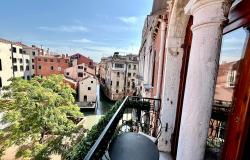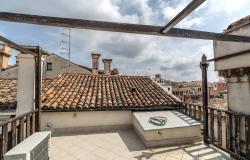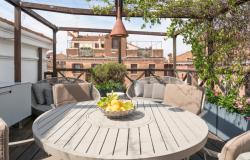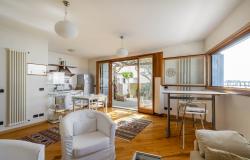If you’re planning on ‘doing’ the Venice Biennale this year (ends November 26th) and if like me you are reluctant to spend the €30 entry fee to see ’cutting edge’ art at the Giardini and the Arsenale, the two main sites, here’s an original suggestion.
Sometimes it’s the unlikeliest shows at the Biennale which prove to be the most interesting, and this year is no exception with the coincidence of two quirky exhibitions which both have intriguing stories to tell about the West Indies.
The Stephen Chambers show at Ca’ Dandolo next to the San Toma vaporetto stop has the added advantage of allowing you to see the inside of a beautiful palazzo on the Grand Canal, normally not open to visitors. The piano nobile, with its ancient rafters, lovely crazed glass windows and terrazzo floor, is sparsely furnished in order better to display the 101 portraits which cover the walls of the salone.
The story behind these portraits is like a fairy tale. Chambers, a distinguished Royal Academy painter, was in New York when he met a poet in Brooklyn and was told about the tiny uninhabited island of Redonda in the Caribbean. A merchant trader called Matthew Shiell had claimed the island in 1865 and nominated himself as its king. His son decided that peerages for the island’s aristocracy would be passed down to distinguished literati. Today, titled members of Redonda’s court include Pedro Almodovar, A.S.Byatt, and Chambers himself, a ‘viscount’.
Chambers has envisaged the entire Court of Redonda in a series of portraits of imaginary inhabitants covering the walls of the grand first floor room. They are brightly coloured head and shoulder faux naïf portraits, some with oddly-shaped hats or colourful patterned clothes, rather like a series of Afro-Caribbean folk images. The men sport unusual beards or moustaches, and the women, embroidered cardigans or vividly patterned blouses and jewellery.

All these pieces comprise one single exhibit and cannot be separated, but in the next room there are three larges canvasses entitled State of the Nation which depict a rider falling from a horse, symbolising the precariousness of the modern world.
One final tip from this exhibition: buy the bag! (See photo.) At €5 it must be the best souvenir of the 2017 Biennale.

Not too far away from the fantasy of Redonda is another astonishing exhibition, a show by the Antiguan artist Frank Walter (1926-2009). This show, in the Centro Culturale Don Orione Artigianelli, Fondamente Nani, is perhaps a little difficult to find: the stickers on the pavements nearby are misleading. The best advice is to look for the entrance opposite the San Trovaso squero (boatyard).

Frank Walter: The Last Universal Man marks the inaugural representation of Antigua and Barbuda at the Venice Biennale.
Walter was an artist, sculptor, prolific writer and eccentric recluse who led an amazing life from his early days as Antigua’s first black manager of a sugar plantation, to his mastery of Latin, sciences and the arts, and his trip to Europe to learn about the latest technology. Sadly, he encountered racist attitudes, was not regarded as an equal, and often went cold and hungry. However, his belief in his aristocratic lineage remained unshaken. As the descendant of a slave owner and a slave, he was obsessed with tracing his ancestry and had delusions of grandeur, comparing himself with Charles II, and awarding himself titles like the 7th Prince of the West Indies, Lord of Follies, and the Ding-a-Ding Nook (geographical names). His attempts at trying to link his ancestry with the crowned heads of Europe are among the many fascinating pieces on display in his show. (And his belief was better founded in reality than the crazy world of Stephen Chambers’ Court of Redonda.)
He returned to the West Indies, to Dominica, and cleared agricultural land which the government promptly confiscated, so once again disillusioned, he eventually became a recluse on Antigua. First he made a failed bid to become Prime Minister, then worked as an artist, photographer and frame maker, living initially above his uncle Stanley’s hardware shop. He later built a house which was no more than a ramshackle hut without access to roads, electricity or running water.
Some of the brashly coloured paintings in the show resemble the portraits of the courtiers of Redonda in Stephen Chamber’s imaginary world, but these are real people. There is even a painting of Prince Charles and Diana, masquerading as Adam and Eve. Again there is a folk art quality to the work: a cricket match, two black warriors fighting to the death, Hitler, and a telling self portrait as a white man, for instance.
The whole show has been expertly curated by Barabara Paca, cultural envoy to Antigua and Barbuda. She has found apt quotations to accompany the work, and provides even more information if you are lucky enough to meet her at the show.
The video of Walter’s many wooden carvings, which often resemble primitive chess pieces, is a revelation, mainly because you hear his voice, assured and rather Churchillian. Despite all the hardships of his life, self belief enabled him to rise above them and enjoy life and the creative spirit. Let Frank Walter speak for himself:
“They called me a Legend, and a Phenomenon, a Meteor and the like, because somehow it was inconceivable that any person on our island would one day rise up to the challenge of the moment.”
- Stephen Chambers: The Court of Redonda, Ca’ Dondola, Grand Canal, San Polo 2879
- Frank Walter: The Last Universal Man, Centro Culturale Don Orione, Dorsoduro 947
Free entry to both exhibitions














